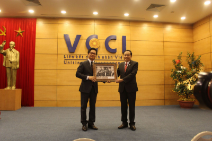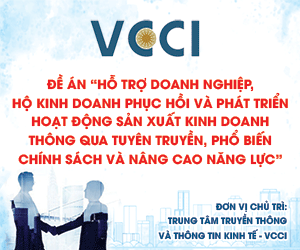Cautious Stance Amid Trade War Escalation
The shocking tariffs announced by the United States on April 2, 2025, negatively affected Vietnam's economic outlook, as the U.S. imposed one of the highest reciprocal tariffs on Vietnamese exports. Although the 46% tariff has been suspended for 90 days for negotiations, uncertainties still weigh on Vietnam's economy in 2025.

Vietnam sees current fluctuations as an opportunity to restructure the economy toward greening, digitalization, and sustainable growth
Immediate difficulties
According to economists, the 10% base tariff currently applied to Vietnamese exports to the U.S. market will not cause too great an economic risk. Vietnam can hope for a positive negotiation outcome but must also prepare for worse scenarios by having appropriate responses and expectations regarding the potential economic impacts of tariffs.
Vietnam’s economic growth reached 6.93% year on year in the first quarter of 2025. This is a relatively positive outcome, considering global economic uncertainties. However, this growth was achieved when Vietnam had not been negatively affected by tariff policies. Many scenarios for Vietnam's economy were put forth when the U.S. government announced the imposition of tariffs on economies around the world. In the worst-case scenario, where a 46% tariff is imposed, the Ministry of Finance’s preliminary estimate indicates that the tariff shock could reduce economic growth by 0.7-1.5 percentage points in 2025. The tariff shock may not have as severe an impact on economic growth as the COVID-19 shock of 2021, but its medium- and long-term effects could be greater due to prolonged trade policy uncertainties.
According to an analytical report by RongViet Securities Corporation (VDSC), the U.S.'s current 10% tariff on Vietnam will be distributed among manufacturers, importers and end consumers, with minimal impact on trade. Importers can increase front-loading inventory in the short term to ease the risk of increased tariffs before negotiations wrap up. If the duty increases further, manufacturers and importers will have less room to absorb profit margin losses, and the increased costs will be passed on to end consumers. Then, importers will look for alternative products and consumers will also cut spending.
In the next 90 days, Vietnamese exporters will have to increase production capacity in a short time. According to the report, the higher the dependence on the U.S. market of Vietnamese goods, the more difficult it is to replace them in a short time if the U.S. tariff on Vietnam is different from other countries, especially some strong products such as footwear, apparels, furniture and seafood.
However, during this period, Vietnam can gain market share in the short term from the U.S.-China trade war because the Vietnam-China tariff gap is quite large, so Vietnamese exporters can get more orders from the U.S. as Vietnamese goods have become an alternative for Chinese goods subject to high tariffs. The most likely industries include toys, footwear, furniture, electronics, apparel and plastics.
The impacts of reciprocal tariffs, uncertainties in trade negotiations, and weaker-than-expected global growth prospects will significantly affect investment in Vietnam, leading to a decline in both domestic and FDI investments.
In addition, weaker-than-expected private consumption due to tariff uncertainties and the high dependence of the Vietnamese economy on exports will weaken confidence and income of households. Tourist arrivals in March 2025 returned to pre-COVID-19 levels, but the direct and indirect impacts of tariffs on the global economy could undermine the ongoing recovery.
Renewing growth drivers
At the 4th meeting of the Government Standing Committee on responses to the new U.S. tariff policy, Prime Minister Pham Minh Chinh affirmed that Vietnam's goals are to stabilize the macroeconomy, promote growth, control inflation and improve investor sentiment.
Vietnam regards current fluctuations as an opportunity to restructure the economy towards greening, digitalization and rapid but sustainable development, he added. This is also the time to restructure enterprises, increase technology application and diversify markets, products and supply chains. Vietnam will encourage large enterprises to participate more deeply in global supply chains.
Prime Minister Pham Minh Chinh requested ministries and branches to immediately study and propose policies on tax and fee exemption and reduction and submit them to the National Assembly for consideration and promulgation in May. The Ministry of Finance will review public investment and have sanctions to handle waste in public investment and disbursement. Public investment disbursement boosting solutions are noted to unleash resources for the economy, create jobs and foster growth. The State Bank of Vietnam will continue to stabilize exchange rates, ensure foreign currencies for import and export, foreign exchange reserves, and strive to reduce interest rates. The banking sector will launch preferential credit packages for certain areas such as the VND500 trillion package for infrastructure, science and technology, and domestic consumption stimulation.
He also requested to reduce at least 30% of costs and business conditions and increase decentralization and delegation of authority. Vietnam also needs to tap its 17 signed free trade agreements (FTAs) more effectively and continue to open new markets such as the Middle East, Eastern Europe, Egypt and South America.
Vietnam and the U.S. agreed to start negotiations on a reciprocal trade agreement, including tariffs. The government established a trade negotiation delegation with the U.S., led by Minister of Industry and Trade Nguyen Hong Dien.
According to a group of authors at BIDV Training and Research Institute, as the world economy is still exposed to risks and instabilities (especially shocking U.S. tariffs), inflation and interest rates may fall more slowly than expected and world economic growth may be low (1.8-2% in 2025-2026), Vietnam's economy is forecast to be quite negatively affected in 2025 and the next 1-2 years. However, if tariff negotiation and trade balancing solutions with the U.S. reach positive outcomes, Vietnam will still maintain certain trade advantages and attract FDI compared to other countries. Along with policies and solutions to stimulate domestic demand and promote new growth drivers from the second half of 2025, GDP growth in 2025 may reach the target.
In order to promptly and effectively respond to the U.S. tariff policy and renew growth drivers, according to the research group, Vietnam needs to seriously and effectively implement its policies on institutional breakthroughs, streamline the organization and apparatus, adjust administrative boundaries, fight waste, and improve the investment and business environment. It needs to pay more attention to measures to enhance mutually beneficial cooperation with the U.S. in many fields, including active trade negotiations, with appropriate and strong policy packages, to reduce reciprocal tariffs (striving for 20-25% from 46%, or lower for specific industries) which are an important content of a bilateral trade agreement with the U.S.. It also needs to promptly address U.S. concerns in the Trade Barriers Report published on March 31, 2025 (especially regarding origin of goods, transit of goods, intellectual property, currency manipulation, energy, pharmaceuticals, e-commerce, telecommunications and cybersecurity). The country also needs to consider further reducing import duties on goods imported from the U.S. while increasing imports from the U.S., especially products that the U.S. has strengths in and Vietnam has demand for (such as semiconductors, LNG, aircraft, aviation equipment, pharmaceuticals, medical equipment and agricultural products.)
At the same time, to renew traditional driving forces, localities accordingly need to decisively implement Resolution 01/2025/NQ-CP and Resolution 25/NQ-CP on growth targets in 2025 assigned to localities; effectively execute private investment and consumption stimulus policies, promote public investment disbursement, and maintain the export front. They will need to better exploit new growth drivers (digital economy, green economy, circular economy and new fields such as AI, energy, regional connectivity and free trade zones) to offset the decline of traditional growth drivers and tariff risks.
Last but not least, it is necessary to enhance the effect of policy management and coordination (especially among monetary policy, fiscal policy, price policy and other macroeconomic policies) and focus on accelerating economic restructuring to mobilize and allocate resources more effectively.








